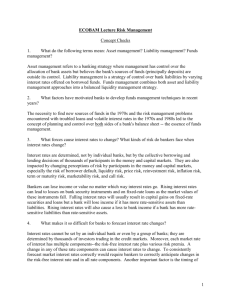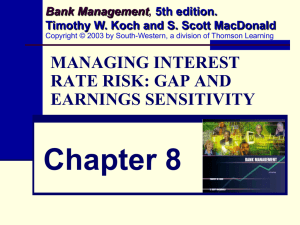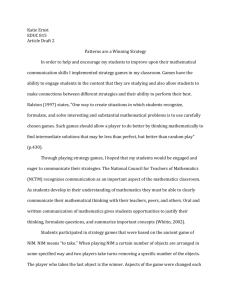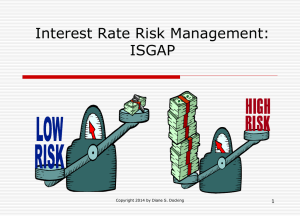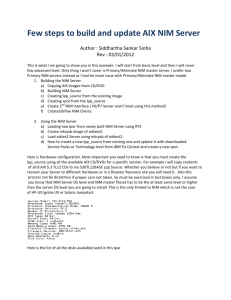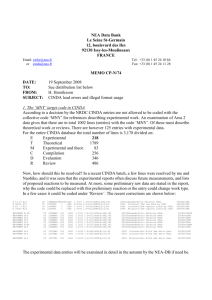Asset-Liability Management: Determining and Measuring
advertisement
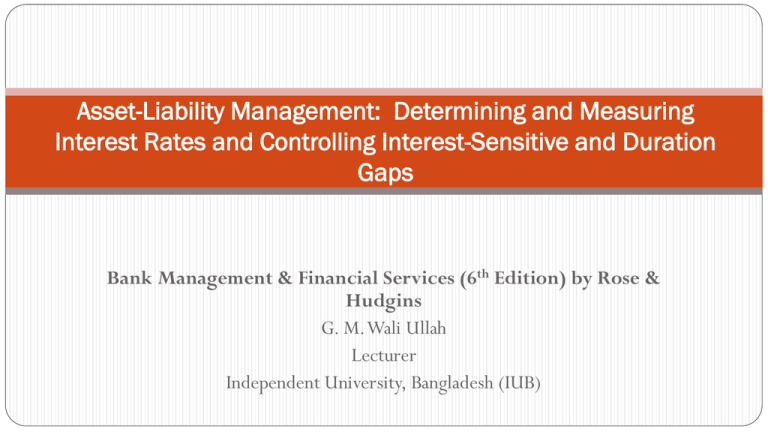
Asset-Liability Management: Determining and Measuring Interest Rates and Controlling Interest-Sensitive and Duration Gaps Bank Management & Financial Services (6th Edition) by Rose & Hudgins G. M. Wali Ullah Lecturer Independent University, Bangladesh (IUB) ASSET-LIABILITY MANAGEMENT The Purpose of Asset-Liability Management is to Control a Bank’s Sensitivity to Changes in Market Interest Rates and Limit its Losses in its Net Income or Equity ASSET-LIABILITY MANAGEMENT • INT REVENUE • INT COSTS Response to changing IR • MKT VALUE OF ASSETS • MKT VALUE OF LIABILITIES NET INTEREST MARGIN INVESTMENT VALUE, PROFITABILIT Y AND RISK NET WORTH Market Interest Rates Function of: Risk-Free Real Rate of Interest Various Risk Premiums Default Risk Inflation Risk Liquidity Risk Call Risk Maturity Risk Yield Curves Graphical Picture of Relationship Between Yields and Maturities on Securities Generally Created With Treasury Securities to Keep Default Risk Constant Shape of the Yield Curve Upward – Long-Term Rates Higher than Short-Term Rates Downward – Short-Term Rates Higher than Long-Term Rates Horizontal – Short-Term and Long-Term Rates the Same Yield Curves Interest Rate Hedging To protect profits against adverse changes in interest rates, management tries to hold fixed the Net Interest Margin (NIM) NIM Interest Income - Interest Expenses Total Earnings Assets Management aims to Insulate the Bank from the Damaging Effects of Fluctuating Interest Rates on Profits Interest-Sensitive Gap Management Interest-Sensitive Gap Management Interest-Sensitive Assets: Interest-Sensitive Liabilities: Short-Term Securities Issued by the Borrowings from Money Markets Government and Private Borrowers Short-Term Loans Made by the Bank to Borrowing Customers Variable-Rate Loans Made by the Bank to Borrowing Customers Short-Term Savings Accounts Money-Market Deposits Variable-Rate Deposits Interest-Sensitive Gap Management Asset-Sensitive Bank Liability-Sensitive Bank Interest Rates Rise Interest Rates Rise NIM Rises Interest Rates Fall NIM Falls NIM Falls Interest Rates Fall NIM Rises Important Decision Regarding IS Gap Management Must Choose the Time Period Over Which NIM is to be Managed Management Must Choose a Target NIM To Increase NIM Management Must Either: Develop Correct Interest Rate Forecast Reallocate Assets and Liabilities to Increase Spread Management Must Choose Volume of Interest-Sensitive Assets and Liabilities Aggressive Interest-Sensitive Gap Management Expected Change in Interest Rates Best InterestSensitive Gap Position Aggressive Management’s Likely Action Rising Market Interest Rates Positive IS Gap Increase in IS Assets Decrease in IS Liabilities Falling Market Interest Rates Negative IS Gap Decrease in IS Assets Increase in IS Liabilities Eliminating Interest-Sensitive Gap IS GAP Asset sensitive Liability sensitive THE RISK POSSIBLE MANAGEMENT RESPONSE Losses if interest rates fall (NIM will be 1. Do nothing reduced) 2. Extend asset maturities or shorten liability maturities 3. Increase ISL or reduce ISA Losses if interest rise (NIM will be reduced) 1. Do nothing 2. Shorted asset maturities or lengthen liability maturities 3. Decrease ISL or increase ISA Problems with Interest-Sensitive Gap Management Interest Paid on Liabilities Tend to Move Faster than Interest Rates Earned on Assets Interest Rate Attached to Bank Assets and Liabilities Do Not Move at the Same Speed as Market Interest Rates Point at Which Some Assets and Liabilities are Repriced is Not Easy to Identify Interest-Sensitive Gap Does Not Consider the Impact of Changing Interest Rates on Equity Position
